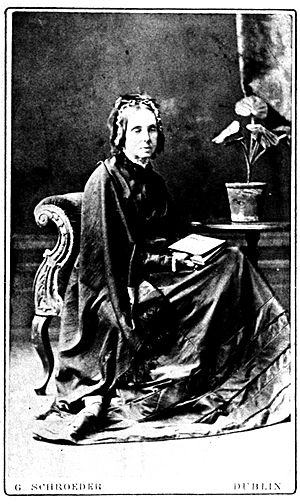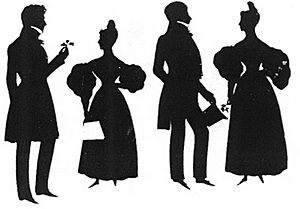Mary Ball (naturalist) facts for kids
Quick facts for kids
Mary Ball
|
|
|---|---|

Ball in later life
|
|
| Born | 1812 Cobh, County Cork, Ireland
|
| Died | 1898 (aged 85–86) Dublin, Ireland
|
| Nationality | Irish |
| Scientific career | |
| Fields | Entomology |
Mary Ball (born 1812, died 1898) was an amazing Irish scientist. She loved studying nature, especially insects. Mary was known for her work with dragonflies and damselflies, called Odonata. She also discovered how some water bugs, called Corixidae, make sounds underwater. This sound-making is called stridulation.
Contents
Mary Ball's Early Life and Family
Mary Ball was born in 1812. She was the second daughter of Bob Stawell Ball and his wife, Mary Green. Mary was born near Cobh, in County Cork, Ireland. Soon after, her family moved to nearby Youghal, also in County Cork.
Mary had three brothers and sisters who grew up with her. They were Robert, Bent, and Anne. Anne was also a famous scientist who studied seaweed.
How Mary Ball Became a Scientist
We don't know much about Mary's early training. But her family was well-off. This meant she likely had tools like a microscope at home. She also probably read the newest books about nature and science.
It is known that her brother Robert started collecting nature specimens when he was only five. We can guess that Mary joined in these adventures too. Robert really encouraged Mary's interest in insects. He even bought her a special book called Systematic Catalogue of British Insects in 1829. Mary used this book to organize her growing insect collection.
Mary Ball's Amazing Discoveries
In 1833, Mary started writing letters to William Thompson. He was a naturalist from Belfast. Mary's insect collection became very large and well-known for her time. Thompson even named about twenty different types of snails and crabs after her. One of these was a tiny snail called Rissoa balliae in 1856.
Mary focused on collecting shells and insects. She built one of the best collections of molluscs in Ireland. After she passed away, her collection was given away.
One of Mary's most exciting finds was a type of migratory locust. This locust was shown in a famous book called British Entomology by John Curtis. Curtis wrote that the locust was found by "Miss M. Ball" in County Waterford.
A Belgian insect expert, Michel Edmond de Selys-Longchamps, studied Mary Ball's collection of Odonata (dragonflies and damselflies). He did this when he visited Dublin. Today, Mary's insect collections are kept in the Natural History Museum in Dublin. Some are also at the Zoology Museum in Trinity College, Dublin.
Mary Ball's Later Years
Mary faced sadness when her father died in 1841. Then her friend and mentor, William Thompson, passed away in 1852. Her brother Robert also died in 1857. After these losses, Mary seemed to stop studying insects.
Instead, she started growing ferns. She was very good at it! One of her nephews even joked, "If Aunt Mary had planted a parasol it would have grown into an umbrella." Mary spent her last years living with her sister Anne in Dublin. She died there in 1898, at the age of eighty-six.
See also
 In Spanish: Mary Ball para niños
In Spanish: Mary Ball para niños


